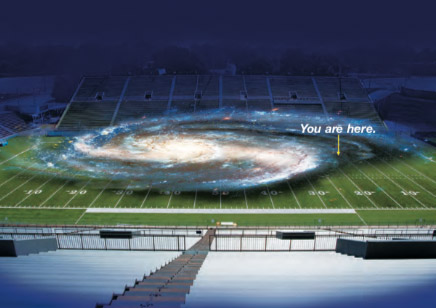Once we get beyond the nearest stars, we can no longer use the 1-to-10 billion scale of the Voyage scale model solar system. After all, we’ve already found that the distance from the Sun to the nearest stars is the distance across the United States on this scale, so there’s not enough room on Earth to go much farther.
We therefore need to jump scales again if we want to make a scale model of our Milky Way galaxy. This time, we’ll jump to a scale of 1-to-1019 (which is a 1 followed by 19 zeros, or 10,000,000,000,000,000,000). On this new scale:
- Each light-year becomes 1 millimeter, and the 100,000-light-year diameter of the Milky Way Galaxy becomes 100 meters, or about the length of a football field.
- If we center the galaxy over midfield, our entire solar system would fit in a microscopic dot located around the 20-yard line, and the 4.4-light-year distance to Alpha Centauri becomes just 4.4 millimeters on this scale—smaller than the width of your little finger.
- If you stood at the position of our solar system in this model, millions of star systems would lie within reach of your arms

Activity
Counting Stars!
Imagine that tonight you are having difficulty falling asleep (perhaps because you are contemplating the scale of the universe). Instead of counting sheep, you decide to count stars. How long would it take you to count the stars in our Milky Way Galaxy? This activity will help you find out.
- To keep the numbers simple, we’ll assume that our galaxy has 100 billion (100,000,000,000) stars, even though the real number is probably several times larger (such as 500 billion to 1 trillion). Briefly discuss why finding the answer to how long it would take to count to 100 billion is still useful even though this is not an exact number.
- Let’s figure out how fast you can count. Time yourself counting from 1 to 10. How long does it take you?
- You probably found that you can count to 10 at a rate faster than one per second. However, it gets harder when the numbers are larger. To see how much harder, time yourself counting from 45,874,549,301 to 45,874,549,310 (which is also just 10 numbers to count). Can you still count faster than one per second?
- Let’s assume you can count at a rate of one star per second (even though you probably found that your real rate would be slower). In that case, it would obviously take you 100 billion seconds to count 100 billion stars. Discuss how you could use a calculator to figure out how long 100 billion seconds is in minutes, then how long it is in hours, days, and years.
- Now use your calculator to calculate how long 100 billion seconds is in years. [Fill in the blank] “So if I start tonight, and never fall asleep or take a break, I’ll be about to count 100 billion stars in the Milky Way Galaxy in _____ years.”
- Discuss the result with your classmates and teacher. Does it surprise you? Remember that most stars have planets, so it’s likely that there are also 100 billion planets in our galaxy that are similar in size to Earth. How does this affect your perspective on Earth? On humanity?
This activity is best done with the whole class working together as you lead them. Specific notes:
- For the discussion, you may wish to point out that we’ve only found the time required to count the stars. It would take even longer to give them names, study them, learn whether they have planets and if any of these planets might have life, and so on.
- As with all these perspective activities, keep in mind that while kids may be tempted to think this makes us small and unimportant, you can also turn this around to focus on how amazing it is that, despite our small size, we have figured out these incredible things. That means we can take great pride in ourselves and our species – at least when we put our brain power to constructive uses.